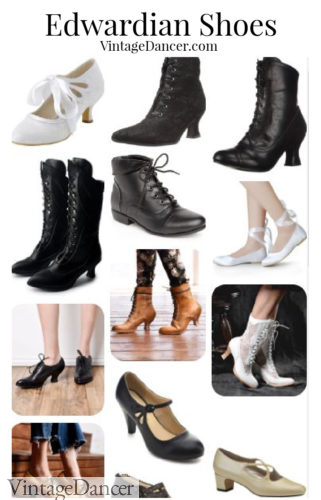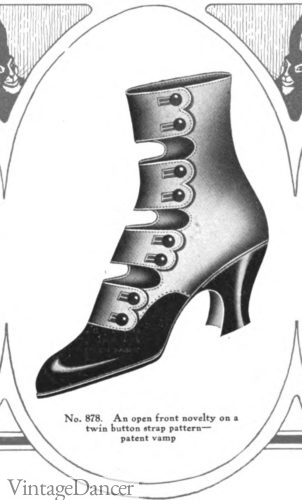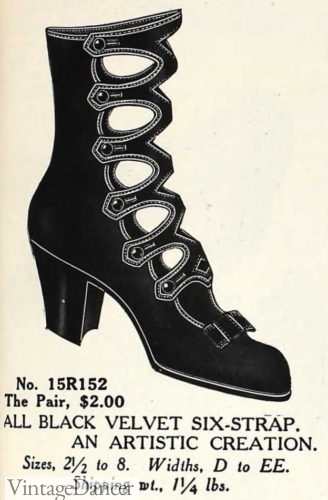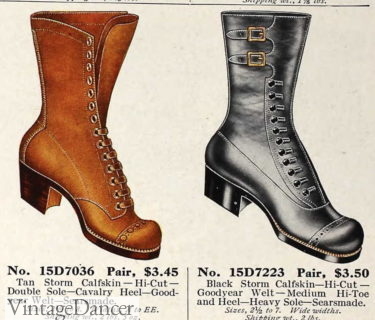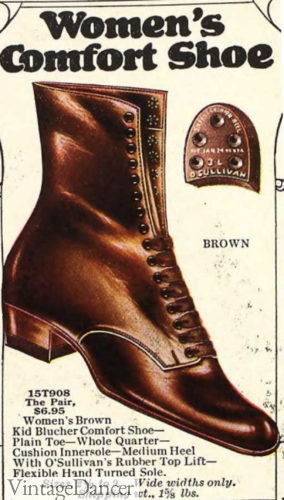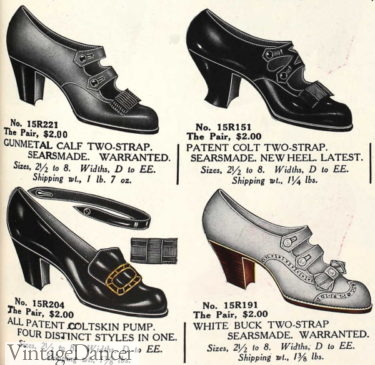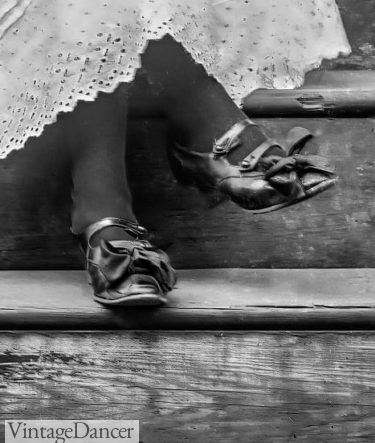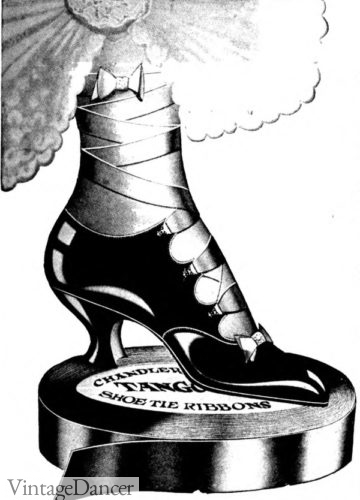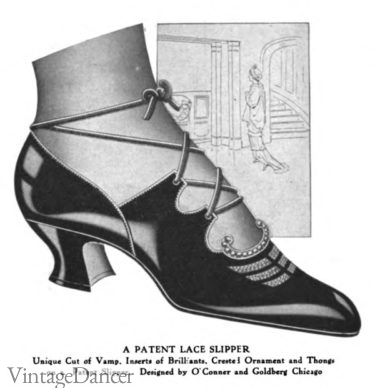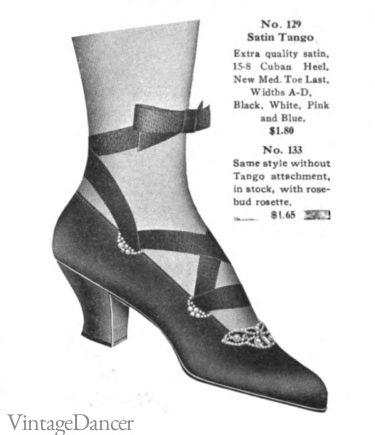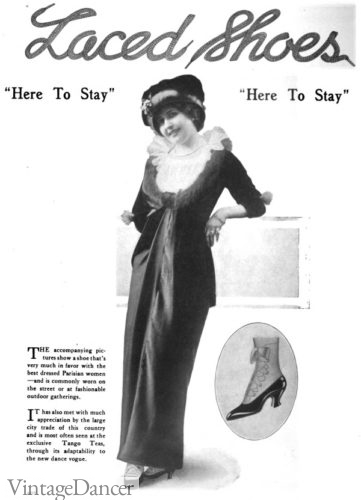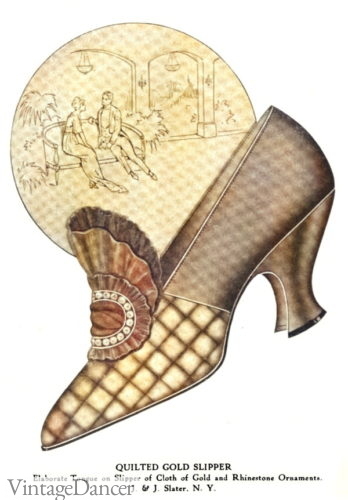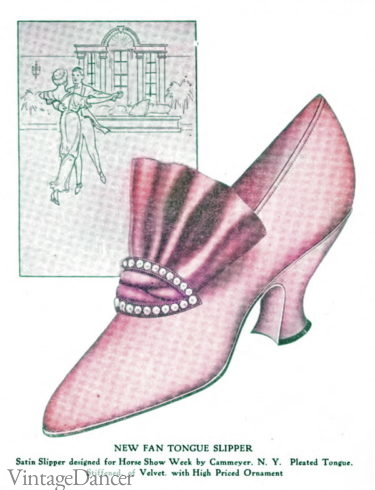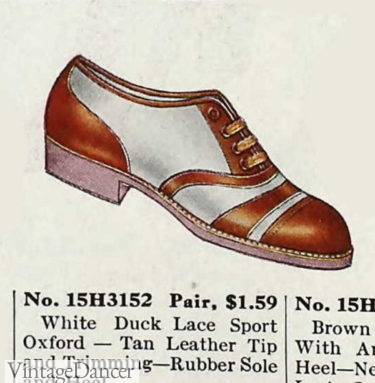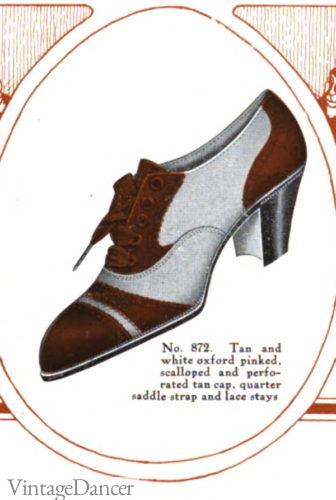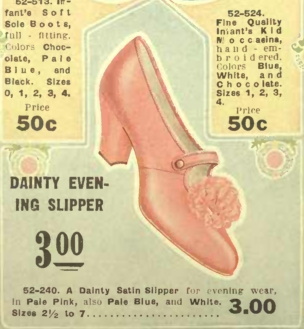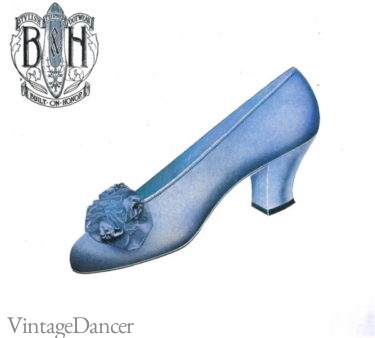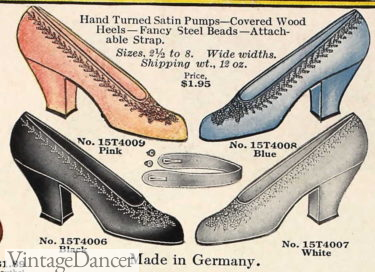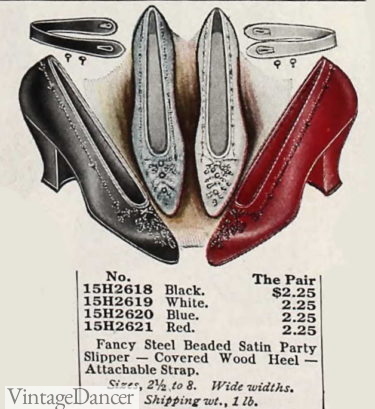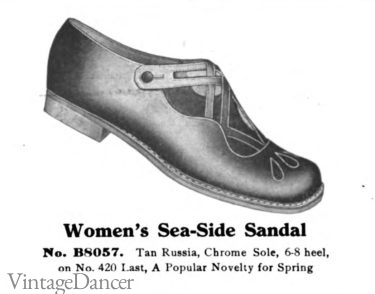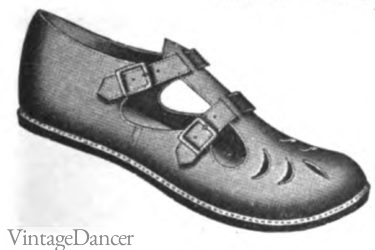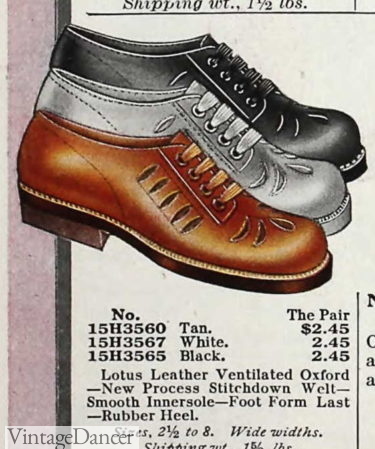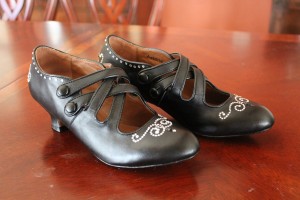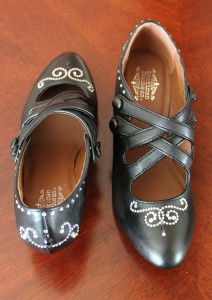As with any antique clothing style, the late Edwardian 1910s footwear had an array of unique boots and shoes. Some styles were deeply rooted in the Victorian era while newer dress shoe styles were moving closer to the shoe styles we know today.
Within the decade the early 1910s, including the 1912 Titanic era, had boots and shoes that were impractical for the WW2 years. From beginning to end, 1910s shoes styles evolved with the changes in society and culture but at a much slower pace.
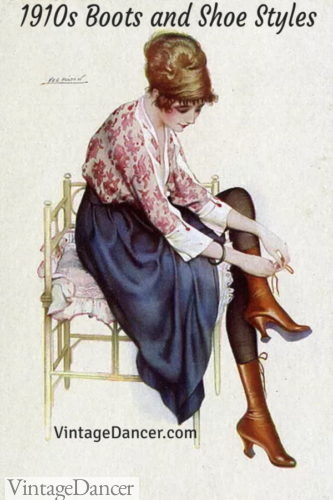
For this article we will take a detailed look at the many varieties of 1910s boots and shoes for women. From high heeled boots to low walking oxfords, sneakers to sandals, and everything in between. The focus is on footwear worn by the middle and lower classes using period illustrations to teach us.
Outside of reproduction shoes, you can use new vintage inspired shoes that have enough of the 1910s Titanic era design to them to make them good costume shoes. At the end of the article I have some ideas on how to decorate plain shoes and give them a glamorous 1910s makeover.
1910s Titanic Era Shoe History
At the turn of the century, shoes were designed to make feet look smaller- curved French Louis heels, tight button or lace boots, and long narrow toes. These illusions quickly lost favor for the more practical heel and wider toe. At the same time time the arches and shaft grew taller so as not to loose all femininity.

1. Louis heel 2. French louis heel 3. Cuban Heel 4. Kidney Heel 5. Cuban-Louis heel
Especially during the war years, Cuban heel boots were favored. There was also a wider French heel called the Cuban-Louis heel that had the delicate curves of the French heel but a sturdier heel block. Similar curved heels were called the spool heel and the kidney heel.
After World War One the narrow French Louis heel came back into footwear fashion stronger than ever.
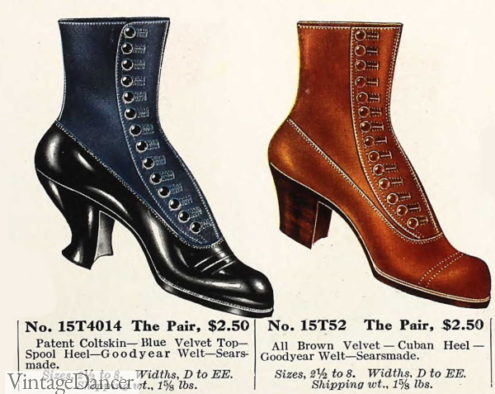
1914 spool (L) and Cuban heel (R) velvet top button boots
Another 1910s Edwardian footwear detail was the height on the arch or instep. In the 1900s heels were a reasonable 1-2 inches. In the 1910s, the heel height jumped to 2-3 inches forcing the foot to step in an unnatural high arch stance. Toes also grew longer to balance out the stride.
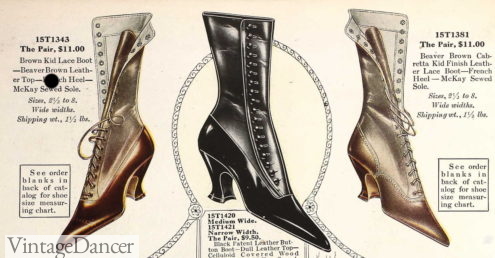
1919 French Louis-heel lace up boots
With rising hemlines exposing more foot, footwear designers turned to color and texture to bring lighthearted fun to classic boots and shoes. Instead of only black leather, boots now came in mahogany brown leather, dark gunmetal grey, and white kid leather. But those were not enough choices.
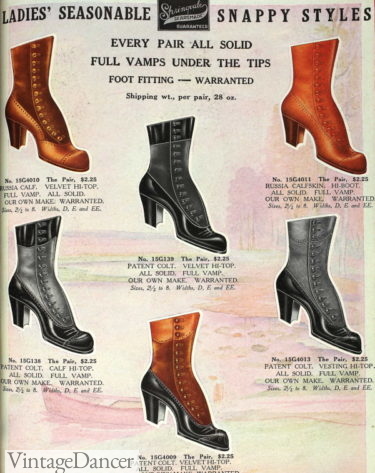
1911 boots
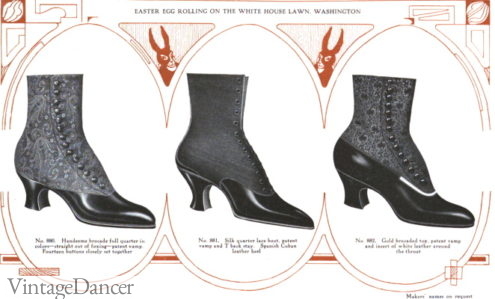
1914 brocade and silk top boots (black and gold)
Fabric top boots made of heavy canvas, felt, brocade, velvet and suede were dyed in rich shades: green, red wine, bright red, navy blue, emerald green, bronze brown, tan brown, medium grey, and deep purple. For summer there was white, pearl, light tan, and light grey.
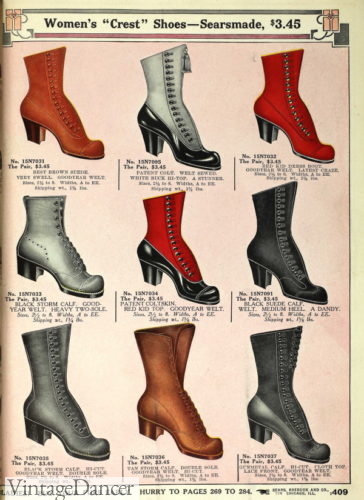
1913 ladies boots- Cuban heels
The foot of two tone boots were black patent leather or a matte leather, usually in black and sometimes in brown (with a brown-tone top.) Popular combinations were black and white, brown and cream or tan, grey and black, and black and a color that matched a ladies outfit. Laces and buttons usually matched the foot bed.
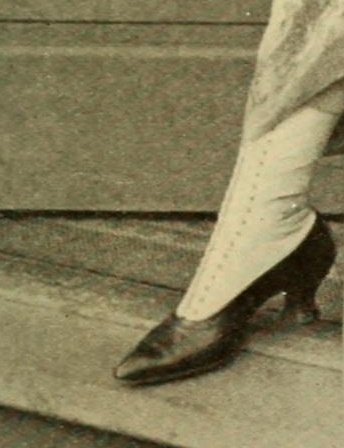
1916 white spat top lace up boots
Two tone boots looked like boot covers called spats or spatterdashers, a button on cover worn over boots to keep them clean.
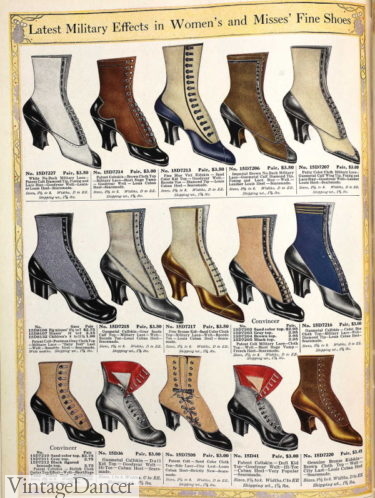
1915 lace up fabric top boots with military style lacing and heels
Since most 1910s women’s shoes were made to order a wealthy lady could choose any color or fabric she desired. Footwear that was chosen to match a dress or outfit was a sign of a ladies’ high society status.
In summer and warm weather a pair of white boot sin leather or cloth were necessary to wear with white or light colors dress – and even dark ones as photographed here:
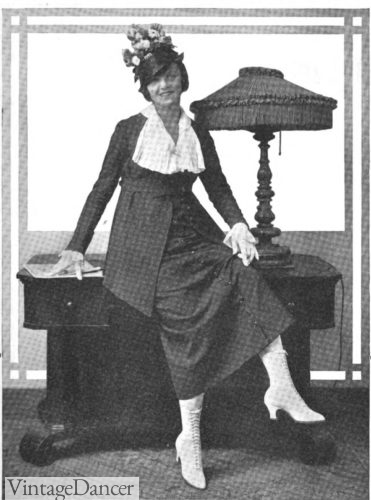
1916 white lace up boots for summer outfits
Most of the Victorian or Edwardian era women’s shoes were tall lace up or button up boots. In the 1910s the lace up boot lost favor for most of the decade. Women preferred the dressier button up boot even if they were more difficult to put on. However, after WW1 button up boots were fading out of style quickly.
Button Boots
Edwardian button boots buttoned to the outer side with a curved edge. A button hook was used to hook the pearl buttons through the eyes- a task often performed by a maid or female relative. This tedious step was one of the reasons they went out of style after the war because women wanted boots that they could do up quickly and independently. The “new woman” had no maids.
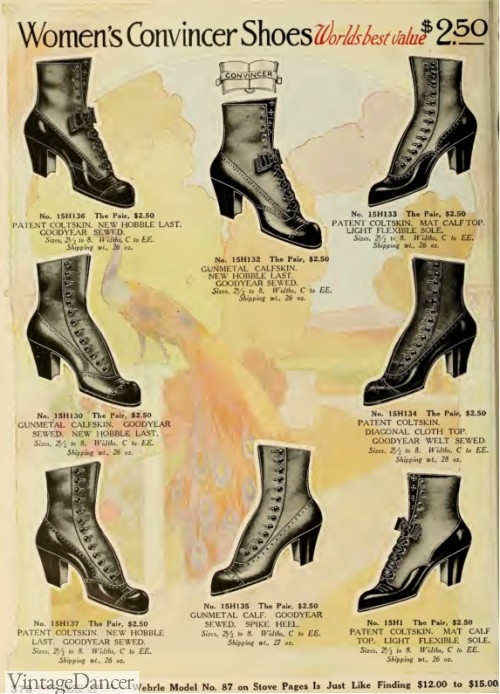
1912 lace up and button boots
Within button boot styles were a brief trend for multiple strap button boots between 1909 and 1914. They have become known as Titanic boots after an appearance in the 1997 Titanic movie. They are sometimes called Tango boots but as you will learn in a moment, those were made of ribbon laces not straps.
Five or six multiple strap boots could be made of soft leather but were the most fashionable in soft velvet.
- 1914 five strap boot, patent leather and brocade silk top
- 1914 velvet strap boots
For comfort, the elderly, in winter, and working conditions women’s lace up boots came with a very short rubber tipped heel, flexible sole and wider toe box. These basic boots were preferred by Edwardian working class women, however since poor women usually purchase boots second hand or from charities, they were at the mercy of whatever style was available. More about winter boots in a bit.
- 1915 winter storm boots with and without buckle top in lace up or button up
- 1919 comfort boot- low heel, wide toe, rubber heel
1910s Shoes – Heels, Pumps, Oxfords
As popular as Edwardian boots continued to be there was a growing demand for dress shoes. Low cut slip on shoes, lace up oxford shoes, and strap shoes wee prettier and cooler in warm weather. The exhibits of Titanic artifacts show that many passengers wore these styles of shoes on board.
The Strap Heel Shoe
An early version of the Mary Jane was common as a short heeled pump with 1- 3 button straps across the foot’s vamp and a moderate heel. Multiple straps were narrow while a single wide strap with cutouts gave the illusion of several straps.
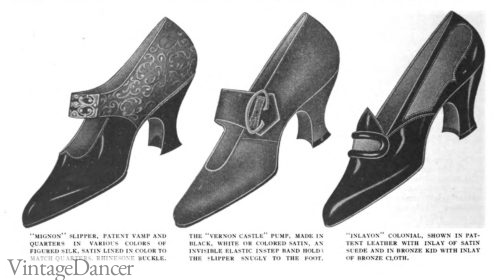
1914 single strap shoes, dance shoes, and colonial pumps
Around 1910-1913 the strap shoe with a flat or full bow on the toe was very trendy, especially with teenagers and young women.
- 1914 two strap and bow shoes
- Photo of two strap and bow shoes
After the start of World War One, strappy shoes became simpler and cheaper with less straps, smaller toe box decorations, broguing (perforations) and color blocking.
The very basic one strap Mary Jane shoe was the cheapest working class friendly shoe. New shoes cost around $20-40 dollars in todays currency. Higher quality shoes were in the $50-100 dollar range with top quality lace up boots costing upwards of $300 by 1919.
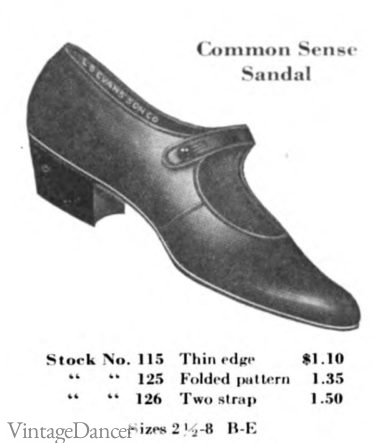
One strap shoes cost $1.10 in 1916 or $30 today
The Peggy shoe was a single strap pump with brown cloth inset into a black leather body. Mixing fabric and leather of matching color or contrasting tan with white, black and white and even grey with green was for the young at heart.
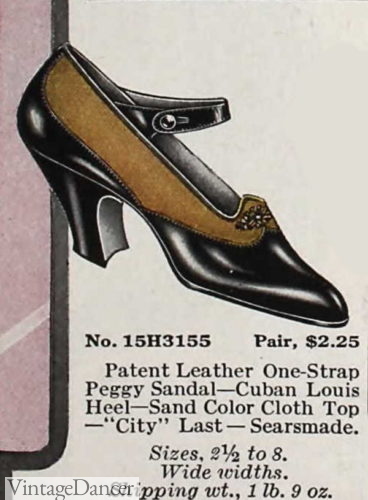
1917 Peggy heels
There was also the ankle strap Mary Jane slip on shoes which was especially popular in summer white duck cloth or shiny black patent leather. Dressy versions were made of silk or satin. Most had a flat bow on the rounded toe box. They featured a low 1 inch heel.
Ankle strap flats were a carry over style from little girls footwear with the nick name “baby doll shoes.”
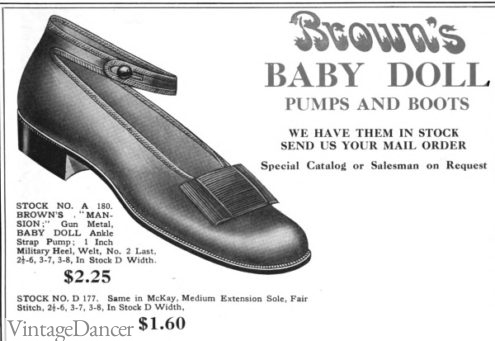
1914 black leather Baby Doll shoes
For dancing shoes, an elastic strap under the top strap held the foot in place the best. A rubber piece on the sole also added traction. Dance should were everything from low heel pumps (with or without a strap), taller heel strap pumps, and even beach sandals.
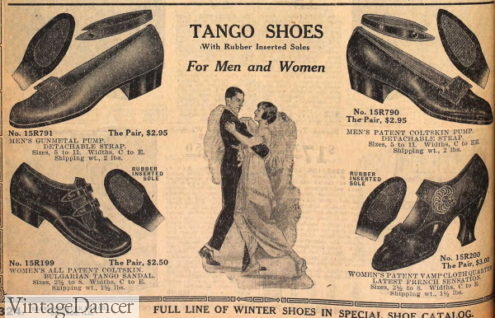
1914 Sears Tango dance shoes
Tango shoes were one style of unique shoe that could be worn for Tango dance or with any dressy outfit. They were all the rage around 1913-14 when the tango dance craze swept the nation. The tango shoes laces criss-crossed the foot and ankle and up part way up the shaft with a wide satin ribbon. Ghillies is another name for lace dance shoes, usually with thin laces instead of ribbon.
More about the history of Tango boots and shoes.
- 1914 tango French heels
- 1914 thin laced ghillies
- 1914 satin tango shoes with diamond decorations
- 1914 black and white tango boots
Slip On Pumps
A slip on pump without straps were trending strong in the 1910s than the decade prior. Women were getting better about walking in them, or they attached a single strap that was now often sold with them. Two shoes in one! Was the way advertisers pitched them.
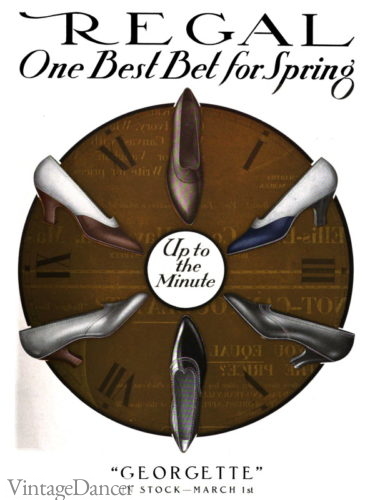
The basic slip on pump was plain with a small bow, buckle, pom pom or shoe clip on the two box. Solid colors or two tone combinations were options. The toe was pointed and elongated to mak the foot appear narrow.
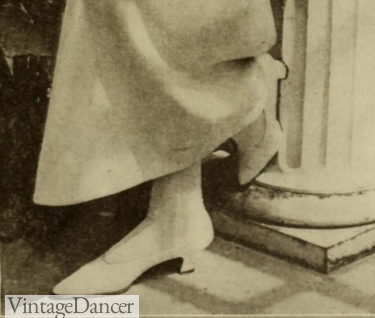
1919 simple pumps
The Colonial pump featured a large tongue decorated in equally large buckle, bow or jeweled clip. They were very stylish and quite the statement shoe.
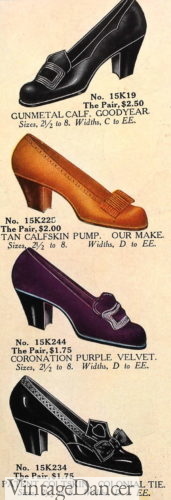
1912 Colonial pumps
The fan tongue shoe was a 1910s footwear trend around 1913-1918. The extra large tongue with smaller buckle looked like the royal 18th century shoes that inspired Colonial shoes. They were popular ballroom dance shoes for the tango, waltz and one step.
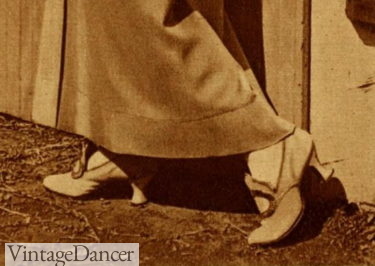
1917 Colonial Pumps
- 1913 quilted gold fan tongue shoes
- Fan tongue shoes 1914
Detachable shoe clips were an affordable way to change up the look of basic shoes. Like straps, they were sold separately as an additional accessory. These black and white rhinestone shoe buckles and clips are an fine example of the how sparkly shoes could be:
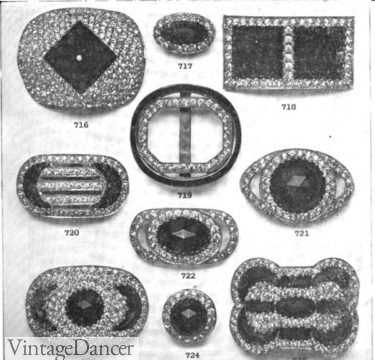
1914 shoe buckles and clips
Oxford Shoes
A dressy shoe that was somewhere between a lace up boot and a slipper was the oxford shoe. Modeled after men’s low profile walking shoes, the ladies oxford featured a higher heel and curved instep.
Around 1912 the shape of the toe went a little crazy with a bulbous shaped “raised toe.” Thank goodness it didn’t last long. While they may have been more comfortable they were not as feminine as the almond shaped toe that came into style after the war.
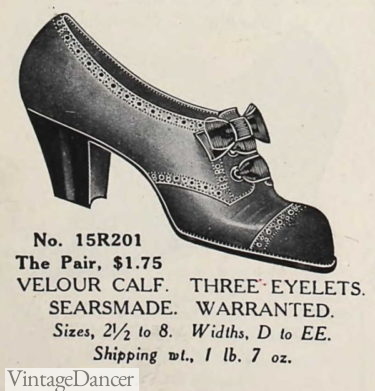
1914 black oxfords with raised toe
Ladies Oxford shoes came in black, brown (tan), white and two tone colors (tan and white, black and white, grey and another color.) They had 3 to 5 eyes which ribbons laced through.
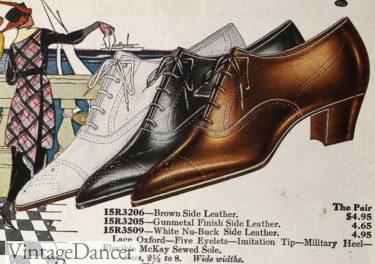
1919 oxford shoes in black, white or tan brown
- 1917 rubber heel low oxfords with white duck cloth and leather trim
- 1914 white and brown high heel oxfords
Ladies oxford shoes with low heels, almost flat, rounded toes and rubber soles became a common working class shoes or sport shoe for all classes.
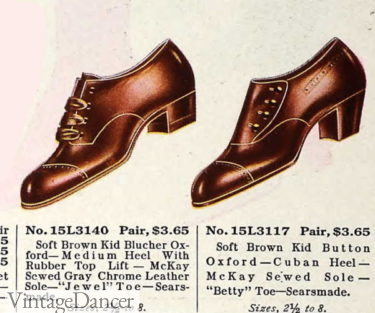
Lace up and Button Oxfords
A similar shoe that buttoned to one side instead of laces was the Button Oxford. The previous decades called them Princess shoes.
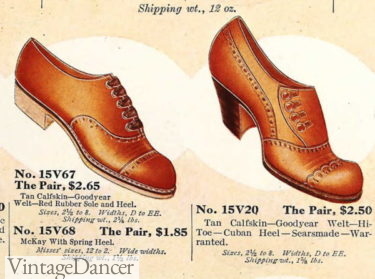
1915 lace up rubber sole oxford and button oxfords
Evening Shoes
Evening shoes were slip on pumps called “slippers”, with a wide bow, rosette, or other decoration on the toe box. Silk or satin shoes may have been embroidered or embellished with glass or steel beads.
Many older styles of party shoes and fancy dress shoes were re-made. Beaded multi strap shoes were brought back from the 1900s. Many women simply wore their older party shoes until after the war returned some prosperity (and parties to attend.)
The wealthy could afford to have shoes dyed to match their dresses. The middle classes would wear white or black, blue, pink, or red that came ready made.
- 1913 single strap shoe with satin rosette
- 1914 blue satin rosette evening slippers
- 1914 evening heels
- 1917 beaded pumps
After the war there was little distinction between special party slippers and a good pair of dress shoes. Patent leather pumps and strap shoes seemed to be the best for winter parties. White leather pumps for the summertime. Moving into the 1920s the idea of simple and shiny pumps and strap shoes replaced almost all fancy evening shoes.
Learn about 1900s Edwardian era shoes styles here.
Sport Shoes
For summertime, gym, sport or leisure activities women had a growing choice in specialty footwear. Both Keds and Converse brand shoe companies had white, brown or black rubber sole shoes with a canvas cloth or leather Nubuck upper.

1915 sport shoes, canvas cloth with white or red rubber soles
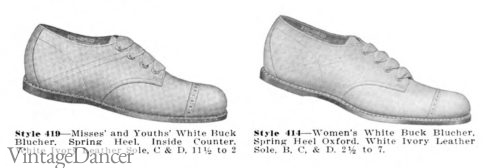
1914 women’s tennis shoes- flat rubber sole and Nubuck top oxfords
Some rubber shoes looked like white oxfords, the ideal ladies tennis shoes or outing shoe. Others looked like the flat sole Keds Champion shoes still made today. And some were high top sport sneakers, like classic Converse. More about women’s vintage sneakers history.
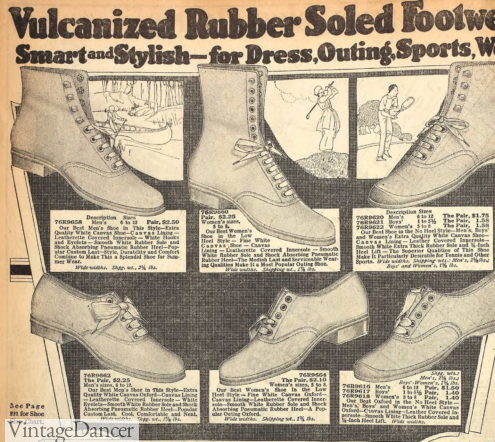
1919 women and men white sport shoes
Both companies made white rubber sole boots, oxfords and slippers for daily wear in the summertime for women, men and children.
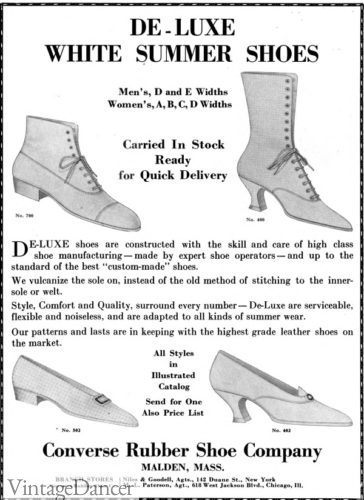
1918 Converse rubber sole boots and shoes
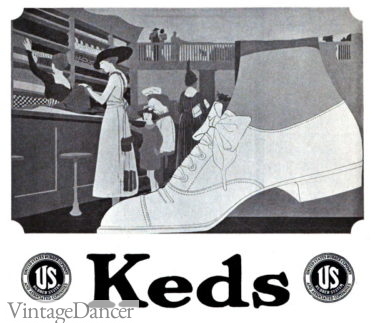
1918 Keds white oxfords
Summer sandals called barefoot sandals, were designed for children but women (and sometimes men) loved them too. They were leather or canvas in the shape of oxford shoes with “ventilation” cutouts on the top and upper sides. T-bar or cross straps increased the air circulation.
- 1914 cross strap sandals
- 1916 child or women’s T bar shoes
- 1917 ventilated oxford shoes
For rugged outdoor sporting such as hiking, camping, horse riding, and biking as well as gardening and farming work, women used tall, almost flat sole, lace up boots. Some had short heels and narrow toes for a more lady-like look, while other cast appearances aside for practical comfort.
Learn more about women’s hiking and outdoor sport clothes and bicycle riding outfits.
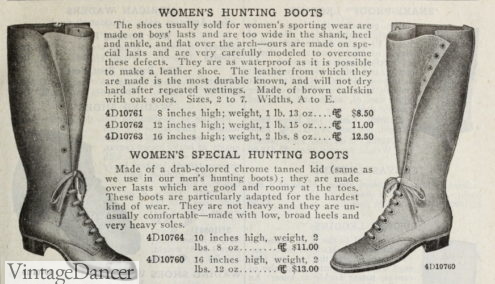
1916 Abercrombie & Fitch Co hunting boots for women
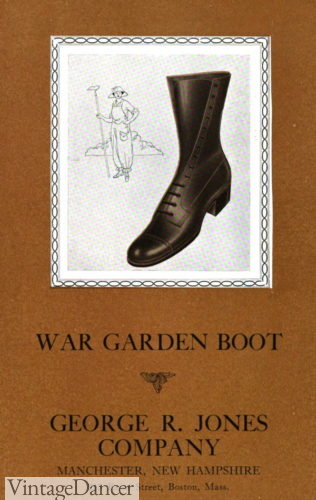
1918 gardening boots
Winter Boots
Similar to outdoor sporting boots were women’s winter ready storm boots. Specialty winter boots were lace up or button over styles with a higher shaft and tighter cuff to keep out the elements. Some had buckles straps at the top. Most winter boots were lined in warm wool fleece.
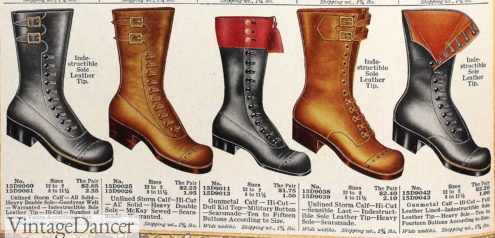
1915 winter boots
The wool felted top boot was best for snow and very cold conditions. Naturally water repellent and warm, they were usually lace up boots with a leather footbed.
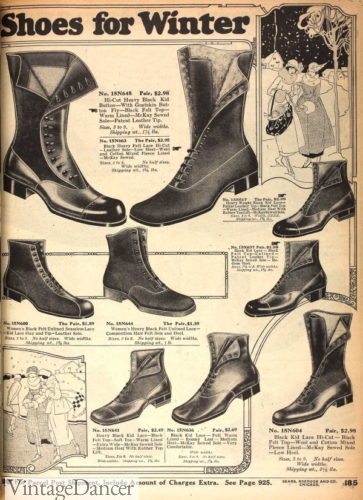
1918 winter felt top boots
Rubber rain boots and shoe covers were better options for rainy weather. Read more.
Carriage boots, renamed motoring boots when cars began replacing horse and carriage, were fur lined ribbon tied fuzzy boots. They were intended to keep feet warm during the ride but not to be worn at the final destination. A pair of pumps were carried and changed into. Motor coots are so cute!
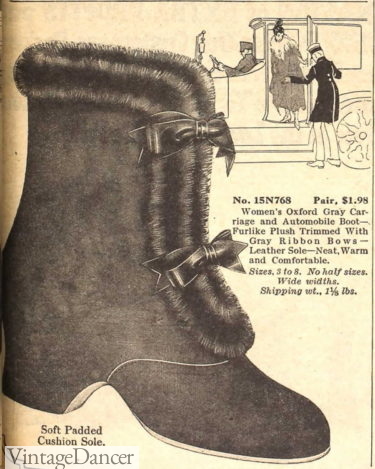
1918 carriage or motor boots
How to Make a Pair of Titanic Shoes
With a few craft supplies and a pair of plain pumps or mules, you can make a pair of 1910s or Titanic style shoes.
1. Locate a pair of plaid colored, low-heeled pumps with a fabric finish like velvet, silk, satin or cotton. Suede or micro-suede can work well, too. Leather will be OK if you don’t have anything else. The color should match your dress. Use black or white, if that’s not possible. Paint your leather shoes with Angelus shoe paints.
2. Find some applique or thick lace trim at your local fabric or craft store. You can even use beaded trim instead of a solid applique. The trim should match your shoes. If it’s a white trim made of cotton or other natural fiber, you can also die it with fabric dye. Man-made material won’t die. You can, however, use fabric paint to change the color.
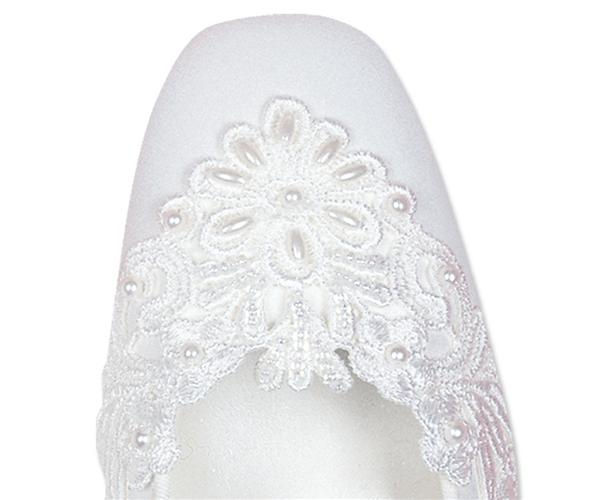 Amazon has shoe appliques for easy peel and stick decorating.
Amazon has shoe appliques for easy peel and stick decorating.
3. Glue, stick or sew on the applique to the top toe of the shoe in a triangle shape with the point pointing towards the tip.
4. Add more beads, rhinestone buckles, bows or jewels for more sparkle. Look in the scrapbooking section of your local craft store for rhinestone stickers!
5. That’s it. You’re done. It’s a very easy project and the results are amazing.
Here are the shoes I made. I started with black Astoria Shoes from American-Duchess and added peel and stick on rhinestone stickers over the toe, heel and edges. The stickers I found were made by Recollections in the scrapbooking section of Michael’s craft store. I love that these are just stickers, so they are temporary. I can decorate these shoes over and over again to coordinate with my dress.
So now you know about the various first class styles of Edwardian Titanic shoes and how to make a pair or buy new shoes with the correct style.
Debbie Sessions has been teaching fashion history and helping people dress for vintage themed events since 2009. She has turned a hobby into VintageDancer.com with hundreds of well researched articles and hand picked links to vintage inspired clothing online. She aims to make dressing accurately (or not) an affordable option for all. Oh, and she dances too.
